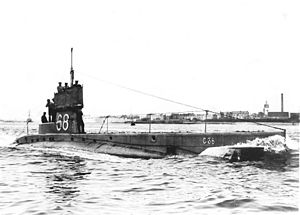
Summary
HMS C12 was one of 38 C-class submarines built for the Royal Navy in the first decade of the 20th century. The boat survived the First World War and was sold for scrap in 1920.
 HMS C38 - a typical C class submarine
| |
| History | |
|---|---|
| Name | HMS C12 |
| Builder | Vickers, Barrow |
| Laid down | 27 November 1906 |
| Launched | 9 September 1907 |
| Commissioned | 19 January 1908 |
| Fate | Sold for Scrap 2 February 1920 |
| General characteristics | |
| Class and type | C-class submarine |
| Displacement |
|
| Length | 142 ft 3 in (43.4 m) |
| Beam | 13 ft 7 in (4.1 m) |
| Draught | 11 ft 6 in (3.5 m) |
| Installed power | |
| Propulsion |
|
| Speed |
|
| Range | 910 nmi (1,690 km; 1,050 mi) at 12 kn (22 km/h; 14 mph) on the surface |
| Test depth | 100 feet (30.5 m) |
| Complement | 2 officers and 14 ratings |
| Armament | 2 × 18 in (450 mm) bow torpedo tubes |
Design and description edit
The C class was essentially a repeat of the preceding B class, albeit with better performance underwater. The submarine had a length of 142 feet 3 inches (43.4 m) overall, a beam of 13 feet 7 inches (4.1 m) and a mean draft of 11 feet 6 inches (3.5 m). They displaced 287 long tons (292 t) on the surface and 316 long tons (321 t) submerged. The C-class submarines had a crew of two officers and fourteen ratings.[1]
For surface running, the boats were powered by a single 16-cylinder 600-brake-horsepower (447 kW) Vickers petrol engine that drove one propeller shaft. When submerged the propeller was driven by a 300-horsepower (224 kW) electric motor.[1] They could reach 12 knots (22 km/h; 14 mph) on the surface and 7 knots (13 km/h; 8.1 mph) underwater. On the surface, the C class had a range of 910 nautical miles (1,690 km; 1,050 mi) at 12 knots (22 km/h; 14 mph).[2]
The boats were armed with two 18-inch (45 cm) torpedo tubes in the bow. They could carry a pair of reload torpedoes, but generally did not as they would have to remove an equal weight of fuel in compensation.[3]
Construction and career edit
C12 was built by Vickers at their Barrow-in-Furness shipyard, laid down on 27 November 1906 and was commissioned on 19 January 1908. The boat was sunk in a collision with a destroyer in the Humber Estuary on 6 October 1918. She was salvaged and recommissioned. C12 was sold for scrap on 2 February 1920.
Notes edit
References edit
- Akermann, Paul (2002). Encyclopaedia of British Submarines 1901–1955 (reprint of the 1989 ed.). Penzance, Cornwall: Periscope Publishing. ISBN 1-904381-05-7.
- Colledge, J. J.; Warlow, Ben (2006) [1969]. Ships of the Royal Navy: The Complete Record of all Fighting Ships of the Royal Navy (Rev. ed.). London: Chatham Publishing. ISBN 978-1-86176-281-8.
- Gardiner, Robert & Gray, Randal, eds. (1985). Conway's All the World's Fighting Ships 1906–1921. Annapolis, Maryland: Naval Institute Press. ISBN 0-85177-245-5.
- Harrison, A. N. (January 1979). "The Development of HM Submarines From Holland No. 1 (1901) to Porpoise (1930) (BR3043)". RN Subs. Retrieved 27 September 2022.
External links edit
- MaritimeQuest HMS C12 page


